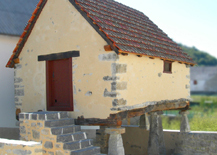
Locality: Orbaitzeta
Address: Valle de Aézkoa
Zone: The Pyrenees
The Valley of Aezkoa,
One of the most beautiful in the Pyrenees, still preserves 15 of the 22 hórreos (raised granaries) in Navarre, which have been declared a Site of Cultural Interest. These buildings, which are concentrated mainly around Aria, Orbaitzeta and Hiriberri-Villanueva de Aézkoa, were devised centuries ago to store grain and protect it from damp and rodents.
The Valley of Aezkoa, extremely popular with lovers of rural tourism, is made up of small, peaceful villages which nestle between mountains covered with meadows and beech and oak woods.
Hórreos
This region of the Eastern Navarran Pyrenees is home to 15 of the 22 hórreos listed as Sites of Cultural Interest. The scarcity of cereal crops and the damp climate typical of this region meant that farmers were already using these small elevated constructions in the Middle Ages to store their precious grain out of reach of rodents.
If you are familiar with other hórreos in the north of Spain, you will find certain differences here. Those in Aezkoa are the Pyrenean type and are distinguished by having a gable roof with almost no eaves, a rectangular shape and walls of untooled stone. They are raised up on pillars of stone, either in a pyramid or in the shape of a trunk, finished off with circular slabs known as ?tornarratas’ that stopped rodents from climbing up.
Some of them have the space between the pillars closed in.
Valley Towns
Take a leisurely stroll through the different villages in the Valley and you’ll come across the hórreos aezkoanos between their stone houses. Garaioa, Hiriberri-Villanueva de Aezkoa, Aribe, Aria, Orbara, Orbaitzeta and Garralda still preserve examples of this popular architecture, known by the names of the houses to which they belong.
The one belonging to Casa Domench (Orbaitzeta) is the largest in the area, while the one belonging to Casa Larrañeta (Orbaitzeta) has retained its wooden structure and original pillars. Some, such as Apat (Aribe) and Reka (Hiriberri-Villanueva de Aezkoa), have inscriptions on their façades and some are still used today as granaries (the hórreo of Casa Jamar in Aribe).
Irati Forest
Remember that, to the north of this valley, you can visit the Irati Forest, the second largest beech forest in Europe after the German Black Forest. It is a sea of trees criss-crossed by tracks, which in spring and summer are decked in brilliant green and in autumn are tinged with a thousand ochre tones.
Listening to the ‘berrea’, the mating call of the stags, enjoying the spectacular scenery or collecting wild mushrooms and strawberries are just some of the pleasures that nature offers the hiker who penetrates these woods. The Collegiate Church of Orreaga-Roncesvalles is also very close by.







